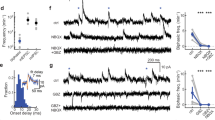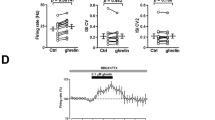Abstract
GLUTAMIC acid strongly excites almost all central neurones examined, and it has been considered to be a main excitatory transmitter in the mammalian brain1,2. Although some neurones in the olfactory bulb have been inhibited by glutamic acid3, this has been explained by the assumption that glutamate primarily activated γ-aminobutyrate (GABA)-releasing inhibitory interneurones, which in turn inhibited the neurones in question1. In the experiments reported here, glutamate inhibited neurones in the granular layer of the cerebellum: this action does not seem to be mediated by inhibitory interneurones.
This is a preview of subscription content, access via your institution
Access options
Subscribe to this journal
Receive 51 print issues and online access
$199.00 per year
only $3.90 per issue
Buy this article
- Purchase on SpringerLink
- Instant access to full article PDF
Prices may be subject to local taxes which are calculated during checkout
Similar content being viewed by others
References
Curtis, D. R., and Johnston, G. A. R., Ergebn. Physiol., 69, 97–188 (1974).
Krnjević, K., Physiol. Rev., 54, 418–540 (1974).
Von Baumgarten, R., Bloom, F. E., Oliver, A. P., and Salmoiraghi, G. C., Pflügers Arch. ges. Physiol., 277, 125–140 (1963).
Yamamoto, C., Jap. J. Physiol., 24, 177–188 (1974).
Chujo, T., Yamada, Y., and Yamamoto, C., Expl Brain Res., 23, 293–300 (1975).
Richards, C. D., and Sercombe, R., J. Physiol., Lond., 211, 571–584 (1970).
Author information
Authors and Affiliations
Rights and permissions
About this article
Cite this article
YAMAMOTO, C., YAMASHITA, H. & CHUJO, T. Inhibitory action of glutamic acid on cerebellar interneurones. Nature 262, 786–787 (1976). https://doi.org/10.1038/262786a0
Received:
Accepted:
Published:
Issue Date:
DOI: https://doi.org/10.1038/262786a0



